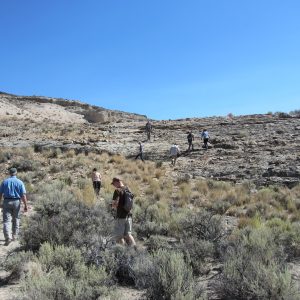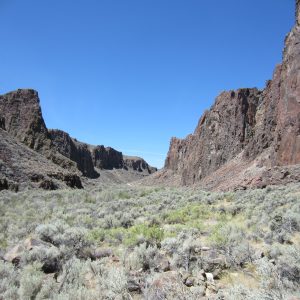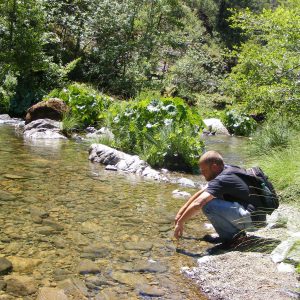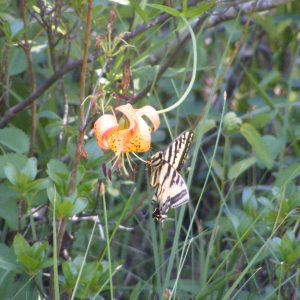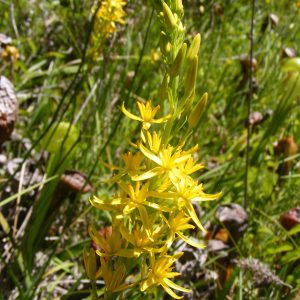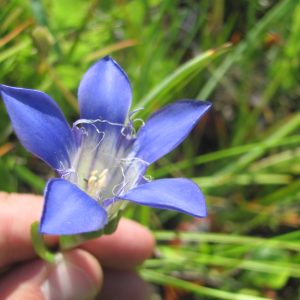Writing my final wrap-up blog came sooner than I expected. The last five months have flown by. I had many great experiences that brighten my resume considerably. I came to this internship with no on-the-job experience with GPS, GIS, seed collecting, habitat assessment framework-HAF, assessment inventory and monitoring-AIM strategy, and much more. Being a BLM employee, I received trainings in hazardous materials, first aid, CPR, and ATV operation. I also participated in big trainings sessions; the Conservation of Land Management workshop, a pollinator course, Interpreting Indicators of Rangeland Health, and a Vegetation Rapid Assessment Relevé. I also participated in taking surveys and researching endangered butterflies and multiple plant species. Outreach events allowed us to work with younger children and teach them about plants, animals, biodiversity and the importance of it all. While these events were keeping me busy, I discovered some of the things that make Nevada special. The scenery at first to me was a plain and boring desert landscape. After spending some time outside I saw beautiful mountains that seemed to never end with breathtaking sunsets and sunrises for backdrops. I was treated to multiple bear sightings while out in the field. The wild horses were very exciting to see for the first time. Overall, the knowledge and experiences gained during my CLM internship are irreplaceable and I would do it again if given the chance.
Back in the office, Ready for Autumn
Field season ended in early August, so since then I’ve been firmly ensconced in the Wetlands field office. It’s been a relatively calm month, mostly revolving around the paperwork that results in the aftermath of field season, and office organization. Data entry is always prominent in the wake of monitoring, and after carefully administering heaps of information into tables, I find myself surprised at the stack of paperwork we managed to generate over the past five months.
In addition to data entry, office organization has become a focus of mine. With the hustle and bustle of people going to and returning from the field, some tasks get pushed to the wayside in the face of higher priority projects. I am now filing hardcopy data in our archives and taking on the tasks of organizing over six years worth of photographs into an easily navigable system of folders; I truly never realized just how many photographs of the wetlands existed until I began sifting through hundreds upon hundreds of pictures.
Later in September and October, I may have the opportunity to assist with seeding native species, and possibly even helping out with National Public Lands Day, but for now I am enjoying the chance to get the office in order.
Hot in the surprise valley!
Hello all,
With the seed collection of two more species and continuing with ESR monitoring on the Lost Creek fire, this past month has been definitely one of the fastest of my time in northeastern California. The seed collection season on the resource area is almost over, we are now only waiting for sagebrush species to seed out to be able to make some good collections of the various species present in the area. In the meantime we have been working on ESR monitoring, which is one of the most time consuming tasks that I have worked on. After GIS selects random points on the different pastures on the burned area, we drive and hike to the site and verify the site to match with the Ecological Site Descriptions so that we can compare it to the paired unburned site. After positively verifying the sites, we began the data collection through transects and different methods mentioned in the protocol. And of course all that data collected needs to be entered in database somehow, so some hours are spent in the office doing that.
Besides from ESR monitoring and seed collecting. I have also worked on surveys on pre and post fire fuel reduction projects (juniper tree stands cuts).
Another interesting activity was a day of riparian areas assessment with a complete team of the range specialist, the wildlife biologist and ecologist where they assessed a few springs on pastures that were up for grazing contract renewal. It was interesting to see the different points of view collaborating to come to a decision for management actions.
I also got the opportunity to join a field office tour of the high rock canyon trail. It was a fun learning trip where we got to see that very remote place with such an amazing geology, soil and elevation diversity.
So far it has been a fun learning experience here at the Surprise Valley looking forward to more learning opportunities.
Until next time,
Hector
2013 Conservation and Land Management Intern
BLM Surprise Field Office
A Time for Reflection
Here we are, the end of the journey that has opened my mind to just how incredible Southern Oregon truly is. I consider myself to be amazingly fortunate that I have this diversified ecosystem as my backyard and all that it contains. I have appreciated so much working with my mentor Doug Kendig and my partner in crime, Marcus Lorusso, over these past months. The skill set that I tackled will help to serve me in my future endeavors for sure. I will never stop thirsting for knowledge to grow and expand my understanding of the world around me, and I have many outdoor excursions planned for myself even after this experience comes to a close.
Darlingtonia californica and the Calochortus howelii have been my two favorite species encountered this summer. One for its awesome carnivorous and sometimes mysterious ways, and the other for its shear beauty and rarity. Marcus has taught me more than I could have imagined over my time here, and I cannot be more thankful. An absolute incredible experience that I will no doubt ever forget. Those I was able to meet in Chicago, I wish you all the best in life and finding your own path. It was astounding to be surrounded by so many brilliant minds; I count myself extremely fortunate. Thanks to Krissa and Wes,
and their team for all their hard work to make all of this possible! Live, love, and enjoy life. Hopefully I’ll have the opportunity to see some of you again soon.
Jonathan Matthews
9/4/13
Another month has come and gone here in Escalante, Utah. The first two things that come to mind are: passing the halfway point of my internship (good and bad) and the monsoon season. The latter is what the locals here call the rainy season. It is very typical for it during this season to be warm and cloudless in the morning. But by the afternoon, thunder storming and heavy rains, especially at the higher elevations. This can make planning our day out tricky sometimes. We came across our first flash flood last week, which was exciting. We must have missed it by minutes because after we turned around I saw in the distance the head of the flood and quickly ran over to watch it rumble by. It was very impressive but slower moving than I had expected.
As for being halfway done with the internship, I feel we have come a long way. We have learned a fair amount about the area in southern Utah, experienced many aspects of seed collecting, and over-come just about all the obstacles we have come across. Speaking of coming across, we saw our second bear not long ago. This time it was only a couple miles outside of town, which is rare, sauntering across the scrubland as we were driving by. It wasn’t exceptionally large but it did have a nice blonde color to it.
We are currently waiting on several populations to ripen at the moment. During the time that we are not monitoring these populations, we are mainly exploring new areas of the monument for plant populations we have not located yet. This has allowed us to see a good deal of the monument, which I am very grateful for.
Lastly, September is the last big month for tourism in these parts. That means we have to get our fill of restaurant food and TV (we don’t have cable) before everything closes up for the fall/winter. I have to say, I am looking forward to the cooler weather though.
Musseling the Neches
The coolest thing I’ve been involved with the last month is helping UT-Tyler biologist Dr. Neil Ford with his mussel surveys on the Neches River. These surveys are part of the ongoing All-Taxa Biodiversity Inventory at Big Thicket NP. 50% of my time as an intern has been helping the ATBI researchers in the field, the other 50% has been spent in the office mapping their findings. Helping out with the ‘Mussel Guys’ has been by far my favorite field activity. A typical day of musseling involves taking an outboard motor fishing boat with a small crew down the river and jumping in the water at 5-6 different locations to comb the bottom of the river with our hands looking for mussels. I had no idea how much mussel diversity exists at the bottom of a river. It’s like a relaxing float trip down the river, only you’re doing science along the way!
Searching for suckers 30+ miles down a dirt road
Sometimes when you travel down dirt roads for a little more than an hour, it can start to make you wonder whether or not you’re ever going to come out. This past week, we went into the deep heart of the Modoc National Forest in northern California in search of sucker species to see how far up the stream system they travel and can be found.
This past week was also my first chance to be crew lead as I had been designated crew lead for the shortnose and lost river sucker. I really enjoyed taking on the responsibility as lead and being able to make my own decisions on the project with the help of my fellow coworkers and being responsible for all aspects of the project. I feel that I really thrive when I am given responsibility and freedom to make my own decisions and choices in the field because I feel that it really aids in my problem-solving abilities and my performance.
Tuesday morning we set out with all of our electroshocking gear to sections of a steam upriver to a reservoir where we knew suckers were present. The river mostly consisted of small sections of flow and larger sections of pools. We concentrated on shocking the pools since that was where the suckers would most likely be. At first we caught a lot of dace and green sunfish (which are beautiful looking by the way) for the first couple of pools. When we arrived at the third pool though we caught our first small sucker which we photographed, weighed, measured and PIT tagged! A couple of pools later, the water started getting deeper and it was getting harder to shock because the fish could swim away more easily. Then, suddenly, while shocking in the middle of the pool, a huge fish jumped up! We missed it the first time and then it jumped up again and we caught it! Lo and behold it was a large sucker! We were all so excited to have found such a big sucker so far upstream! After that, we continued to find some suckers in different sections of the streams, so the week of surveying was a success!
It was also a success because the area hasn’t been surveyed for suckers in about 20-30 years. Therefore, our findings could hold significance for the scientific community and for endangered sucker restoration/conservation! The lead biologist on suckers here at the office who I am working with is actually going to have me write a manuscript on our findings which may be published! I never expected that to be a possibility this summer, but I am sure glad to have it!
Until next time,
Kaitlyn Farrar
The End of an Era, the Beginning of a Legend

Fist-bumping, bro-hoofing, or BLM legending, whatever you call it, were common ways to express the overjoyous feeling of ES&R monitoring well done, sir.
From where do I begin to summarize my internship experience this summer? From the quiet humble beginnings of plant identification, preparations, and map-making to the desert-trotting antics of a knowledgeable and thorough ES&R monitoring machine, the summer presented a vast array of challenges that we systematically overcame. Without the help and support of my fellow intern, Justin, and the Burns District BLM range staff, my internship may have been much more frustrating than it was rewarding. The range staff was immensely helpful this summer with plant identification, navigation, and monitoring protocols. Additionally, I feel as though I have made lifelong connections as a result of this internship.
Photocard after Photocard, Transect after Transect, the ES&R Monitoring Crew of the Burns District BLM gets the job done, and done right 95% of the time, every time! All in all, ES&R crew was responsible for all fires which received some form of treatment over the past 3 years. For the Burns District, this meant monitoring and reporting on 7 fires; DSL, Miller Homestead, Lamb Ranch, Holloway, Desert Meadows, Slope, and Smyth Creek.

After searching for over an hour, the mysterious trendsite of invisibility was located and read for the first time in nearly 30 years!
The turning point of my internship was most likely our first major monitoring assignment; the Miller Homestead Fire. This was the second largest fire of 2012 in the Burns District, and received a vast array of treatment techniques through the use of ES&R Funds. More than 5 treatments were used; aerial chemical treatment, aerial seeding, high risk seed mix, extreme risk seed mix, and sagebrush seeding among others. To evaluate the effectiveness of these treatments, at least 25 trendsites were monitored on this fire alone, crossing both resource areas in the Burns District.
This is where I learned the true value of calibration, organization, and teamwork. Many plots had to be separated out by treatment type, and figuring out what treatment took place where was a challenge in of itself. Figuring out how to navigate to each site, and then ensuring that all of the proper paperwork, supplies, and tools were brought along each day was also incredibly challenging. We eventually figured out the protocols, the checklists, and the processes that needed to take place for accurate, efficient, and safe fire rehab monitoring. Justin and I were truly pioneers in this regard, conducting more monitoring for our district than had ever been done before. This really prepared us for monitoring in the extreme terrain of the Trout Creek Mountains, another mega project we accomplished this summer.
The Trout Creek Mountains compounded the initial challenge of the Miller Homestead Fire. It was early July when we started living and working in the BLM bunkhouse in Fields, Oregon. Everything had to be planned out well in advance. This included having enough supplies to last for a whole week of monitoring, and not just planning a day at a time. Before we left for the bunkhouse each Monday morning, we went through a checklist:
| water | rebar | hammer | carpentry rulers | Paperwork | GPS | pin flag |
| food | angle iron | post pounder | compass | pencils | markers | clipboard |
| radio | witness post | density square | camera | photocards | batteries | Juno GPS |
Once the checklist was complete, we set forth into the field. This involved using work truck to tow a trailer which held our UTV. We would leave by 5:00am at the latest every morning to get a jump start and avoid as much heat as we could, and it was hot working near and over the Nevada border. An additional 25 or so trendsites were read in this steep mountainous terrain. This is where we learned to properly plan to work in an extremely harsh and unforgiving environment. We learned “Proper planning prevents pitifully poor performance” and the importance of communication. For every trendsite read, it was of the utmost importance to communicate with the range conservationist who was responsible for the area. This ensured smoother trend site relocation, accurate history of the site, and proper photo orientation to continue the ongoing dataset of the site.
Once all of the trendsites in the Trout Creeks were “read”, we were given the task of performing additional monitoring throughout the burn area. Sites were randomly chosen with a GIS algorithm, and we loaded over 100 points onto our JUNO GPS. We then systematically went to each point to record perennial plant density, to further evaluate the landscape recovery. By this point, we were essentially the masters of plant identification and ES&R protocols. Within 3 weeks, we had hit all 100+ points in several pastures throughout the Mountains.
We then turned our attention toward some of the smaller fires within our district, and began to establish several new trend sites which will be continually monitored for at least another 2 years. Once all of the monitoring was complete, we began data entry, photo organization, analyze data through graphs and figures, and finally end of year reporting. Last week, we finished all of our ES&R reports, and completed a final overall report for the current ES&R year, ON TIME! More recently, we have been preparing files, lists, and protocols for a new batch of interns to take over next year. We noted which plants were found where in the district, and updated a PowerPoint we made of all the plants in our district. Our mentor has already told us how impressed he has been with our work this summer, and that he already has plans to hire CLM Interns next year!
I am leaving my internship earlier than planned in order to prepare for my departure into the Peace Corps! I will be training to become a Sustainable Agriculture Volunteer in Ghana beginning on September 30th, only 26 days away! There is much I need to do before I can depart, but I am incredibly excited about my upcoming adventure. This internship was a great stepping stone between college and my Peace Corps Service, and I had a great experience.
Signing Off,
Dan Mayer
Burns District BLM
Hines, Oregon

Photocard after Photocard, Transect after Transect, the ES&R Monitoring Crew of the Burns District BLM gets the job done, and done right 95% of the time, every time!
The End (cue the Beatles song)
I remember, back in middle school, how the summers used to lazily drift by. Fall, winter and spring were all terrifically busy, but for those few warm months I had all the time in the world and it seemed like forever (not in a bad way) until the seasons turned. Now, out of college, my experience is reversed. The warm season is full to the brim with work, traveling and of course lots of outdoor adventures, while the winter months can be almost lackadaisical. I have to say though, that this summer may have gone by the fastest out of any so far! As I look out over the Bodie Hills, richly colored with turning aspen, it seems like only a few days ago that those same hills were still white with patches of snow. The sage grouse chicks that weren’t even eggs when I arrived are now fully grown, and plants that I couldn’t ID for lack of flowers in the early spring shed their last seeds months ago. Its pretty crazy, but I can’t complain – life flies when you’re having fun.
That’s right, even a job can be fun! While I can’t say I will miss the miles of bumpy roads, some tedious surveys and the occasional day where I didn’t bring enough water for the heat, I have genuinely enjoyed my CLM experience here in Bishop. My co-intern Leah, mentor Martin and all of the rest of the BLM staff were truly fantastic and I feel pretty lucky that I got to spend my summer here with them. Every day is spent somewhere beautiful and I do feel that the work the BLM does here is improving the prospects for the area’s flora and fauna, as well as recreational opportunities.
It hasn’t been all fun and games though, I’ve learned to use oodles of new monitoring techniques, how to find sage grouse with radio-telemetry and all about seed collection from start to finish. I’ve also learned a ton about the ecology of the great basin, how to reverse an outlandishly huge truck a mile and a half down a narrow dirt road, and maybe, just maybe, I’ve learned a little about myself. I know that I like being outside, and dislike driving to get there. I know that I can ID plants better than most folks, but have no interest in becoming a professional taxonomist or anyone who specializes in identifying sagebrush. I also know that while the desert sagebrush landscape and the white granite of the eastern Sierra are both beautiful, my heart is tied to green trees and rivers that eventually reach the ocean.
What I don’t quite know still is what exactly I want to do with my life. Working for the BLM has made me more aware of the upsides and downside of a career with a government agency, but I don’t know that the experience has pushed me in one direction or the other. I’d like to find a graduate program in ecology, but after a summer of exploring dozens of different projects, its hard to picture tethering myself to one very specific corner of research. I guess we’ll have to wait and see how the fall goes. I have a feeling that with things not traveling at light speed, I’ll have time to organize my head a bit. Fortunately, I’m sure that wherever I end up, this internship will be good preparation, partly because of the skills that I’ve learned, but mostly because of the initiative that I was allowed to take on projects. Its definitely been a growing experience, and even though my 5 months has flown by, it was certainly a good time while it lasted.
Shoutouts to my mentor Martin and co-mentor Sherri for going out of their way to make my internship experience an awesome one. Also shoutouts to Krissa, Wes and the other staff at Chicago Botanic Garden (and the BLM too, for that matter) for being so easy to talk to and, in the CBG’s case, orchestrating a great workshop. Finally, to all my fellow CLM’ers, especially my co-intern Leah, it was truly a pleasure to get to know all of you, at least a little bit. No matter where exactly we end up, I’d be surprised if I didn’t cross paths with at least some of you later in our careers. Hopefully we can go hiking too!
Until next time, happy trails,
Bridger Cohan
A good chance of Monitoring in the morning with isolated Collections in the afternoon
Finished up the monitoring for the season with a trip up to Walden, CO to complete the monitoring on Phacelia formosula, a trip out to Silt, CO and up onto the Roan Plateau to a shutdown oil shale site for Penstemon debalis monitoring and finally a trip out to Montrose, CO to complete the monitoring on Eriogonum pelinophilum and establish several new monitoring plots. The week in Montrose was the week of rain here in Colorado with several systems passing over the state but as always whether rain or shine we were in the field completing the work at hand. The rain and the Adobe gave us the opportunity to experience mud caked boots which in turn gives you a better perspective of the land as you gain 2-3 inches in height as well as a higher intensity hike to your field site, an enjoyable experience of hiking in the rain and running through mud. Seed collections haven’t stopped with several more completed at our Leadville location, a couple more completed at the Kremmling location and a revisiting of the Strawberry location near Fraser, CO for a collection of an Orthocarpus luteus and a status report on the Castilleja sp. and Dasiphora fruticosa ssp. floribunda.
Nathan Redecker
Lakewood, CO
Colorado State Office

